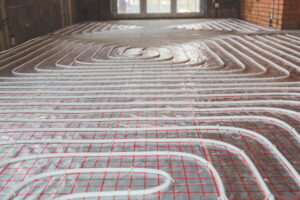If it’s time to upgrade your heating system, you may be considering replacing a forced air system with radiant heat instead. While radiant heat is a great option, it does have some downsides that you need to consider before making the leap.
You can keep reading to learn more about the many benefits of a radiant heat system, as well as the potential disadvantages. Then you can give our team a call to schedule heating service in Morton Grove, IL. No matter what type of new heating system you decide to go with, our team is here to help.
Benefits of Radiant Heat
A radiant heater is unique because it uses water to transfer heat throughout your home instead of heating air and blowing it through vents. Water is a much better conductor of heat compared to air, so radiant heat systems are very efficient to operate.
They also offer the added benefit of radiating heat out into your home after the water is done flowing through the pipes. This is because the pipes themselves remain hot after the water passes through. You stand to save a lot of money on your monthly energy bills with a radiant heater since they are so effective.
Plus since the pipes are down low, heat radiates up through your rooms. Many forced air systems use ductwork that blows down from ceiling vents. Since heat rises, a lot of the warm air can pool on your ceilings instead of making its way down into your home. Radiant heaters elevate comfort in addition to being efficient when it comes to energy use.
Radiant heaters also tend to be a more low maintenance option compared to a forced air heater. There are fewer moving parts that have the potential to malfunction and need repairs. Of course, you should still schedule annual maintenance for your radiant heating system just to be safe and stay on top of any potential issues.
Installation Considerations
The one thing you really need to think about when it comes to investing in radiant heat is that the installation process is very involved. A radiant heater uses pipes that are installed in your floors or the walls of your home. Because of this, it can be an overwhelming project to remove your floors or walls and install the piping.
Most of the time, homeowners do not invest in radiant heat unless they are already undergoing a major home renovation or are building a home from the ground up. If you have an existing home with a forced air system, installing a radiant heater may be more trouble than it is worth.
If you already have a radiant heater, replacing it with a newer model is a fairly simple process. Most of the radiant heat network can remain in place and you just have to upgrade the main portion of the system.
Contact Roberts Heating & Air Conditioning, Inc. today to schedule your radiant heating appointment as soon as possible.


